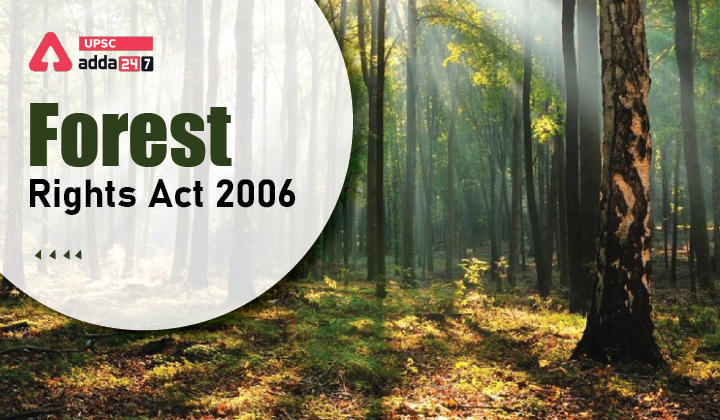Table of Contents
Forest Rights Act 2006- Relevance for UPSC Exam
General Studies III- Welfare schemes for vulnerable sections of the population by the Centre and States and the performance of these schemes; mechanisms, laws, institutions, and bodies constituted for the protection and betterment of these vulnerable sections.
In News
Odisha is aiming for a full rollout by 2024 while many States are nowhere near completing the implementation of the historic Act
Colonial Legacy
- Tribal and forest-dwelling communities living within the forests in harmony with the environment and the ecosystem started facing tenurial insecurity as the British diverted the abundant forest wealth of the nation to meet their economic needs.
- The Indian Forest Act, 1927 which dealt with the rights of the forest was not followed.
Historical Background on Forest Rights
- National Forest Policy, 1988 talked about the need to associate tribal people in the protection, regeneration, and development of forests.
- To protect the marginalized socio-economic class of citizens and balance the right to an environment with their right to life and livelihood.
Forest Rights Act 2006
- Enacted in 2006 and implemented in 2008 it deals with the rights of forest-dwelling tribal communities and other traditional forest dwellers to forest resources.
- Grants legal recognition vesting the forest rights and occupation in Forest land to Forest Dwelling Scheduled Tribes (FDST) and Other Traditional Forest Dwellers (OTFD) who have been residing in such forests for generations.
- The Gram Sabha is vested with the authority to initiate the process for determining the nature and extent of Individual Forest Rights (IFR) Community Forest Rights (CFR) or both that may be given to FDST and OTFD.
Eligibility
- Those who “primarily reside in forests” and who depend on forests and forest land for a livelihood.
- The claimant must be a member of the Scheduled Tribes scheduled in that area or must have been residing in the forest for 75 years.
Recognition of Rights
- Gram Sabha, or village assembly, to pass a resolution recommending whose rights to which resources should be recognised.
- Resolution is screened and approved at the level of the sub-division (or taluka) and subsequently at the district level.
-
Rights Under the Forest Rights Act
- Title Rights
- Right to ownership to land farmed by tribals or forest dwellers subject to a maximum of 4 hectares to FDST and OTFD
- Ownership is for the land that is cultivated by the concerned family.
- The rights of the dwellers extend to extracting Minor Forest Produce as well.
- Forest management rights
- The right to protect, regenerate or conserve or manage any community forest resource which they have been traditionally protecting and conserving for sustainable use is included in FRA.
-
Significance
- Expands the mandate of the Fifth and the Sixth Schedules of the Constitution that protect the claims of indigenous tribal communities over land or forests they inhabit.
- Regulates the exploitation of forest resources by officials, improves forest governance, and better management of tribal rights by ensuring that people get to manage the resources on their own.
Rights for the Dwellers in the news
The Forest Rights Act, of 2006 entails
- Tenurial security over the forestland under occupation prior to December 13, 2005.
- Recognition of forest right over forest and forest product.
- Protection and conservation of forest community resources.
- Conversion of all forest villages’ habitation located inside the forestland into revenue villages.
- In-situ rehabilitation of displaced persons evicted without compensation prior to December 13, 2005.
- Recognition of ancestral domain (habitat) right to particularly Vulnerable Tribal Groups.
- Seasonal access to nomadic, pastoral, and semi-nomadic communities over forest land.
- Conversion of all leases by erstwhile governments, zamindars, and kings into permanent land records.
Issues with Forest Rights Act
- Lack of active political involvement.
- Lack of adequate human and financial resources with the Department of Tribal Affairs.
- Lack of coordination with forest officials
- Inadequate functioning of district and sub-division level committees, which consider the claims filed by Gram Sabha.
- Only 13% of the 40 million ha has been demarcated under the FRA by the environment ministry.
What can be done?
- Awareness campaigns should be organized at the local level to inform about the provisions of the act to the local people and the officials.
- Training and capacity building of people responsible for implementing the FRA, such as Panchayats, Gram Sabha, and village-level Forest Rights committees should be held regularly.
- The time frame should be defined clearly for settling the claims in a timely bound manner.
| Follow US | |
| UPSC Govt. Jobs UPSC Current Affairs UPSC Judiciary PCS Download Adda 247 App here to get the latest updates |



 TSPSC Group 1 Question Paper 2024, Downl...
TSPSC Group 1 Question Paper 2024, Downl...
 TSPSC Group 1 Answer key 2024 Out, Downl...
TSPSC Group 1 Answer key 2024 Out, Downl...
 UPSC Prelims 2024 Question Paper, Downlo...
UPSC Prelims 2024 Question Paper, Downlo...
